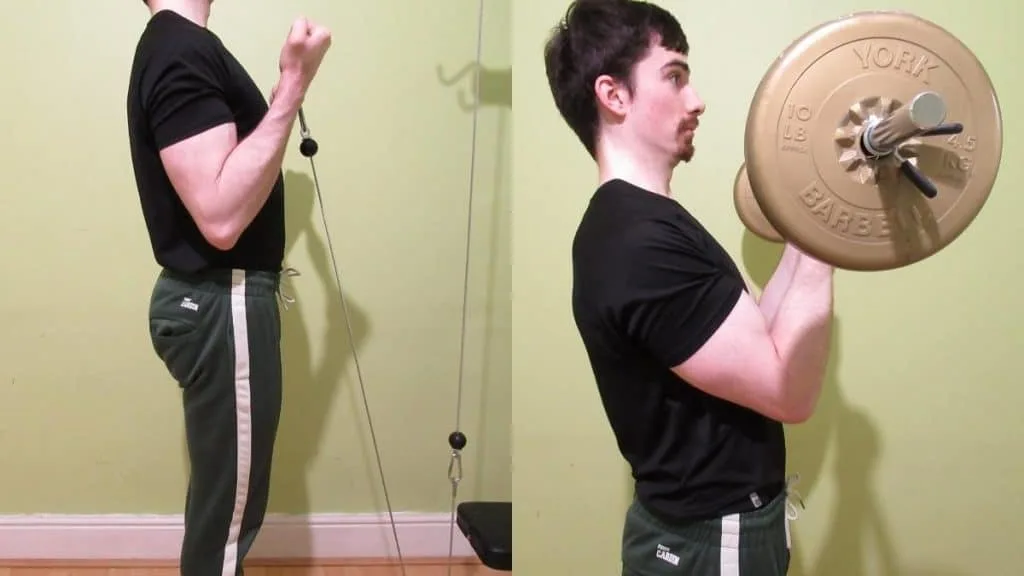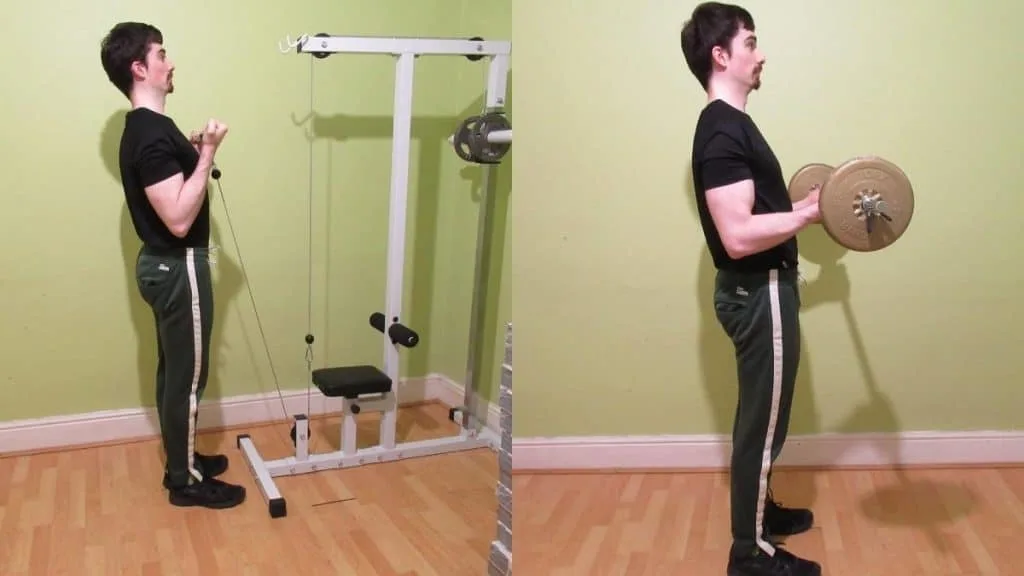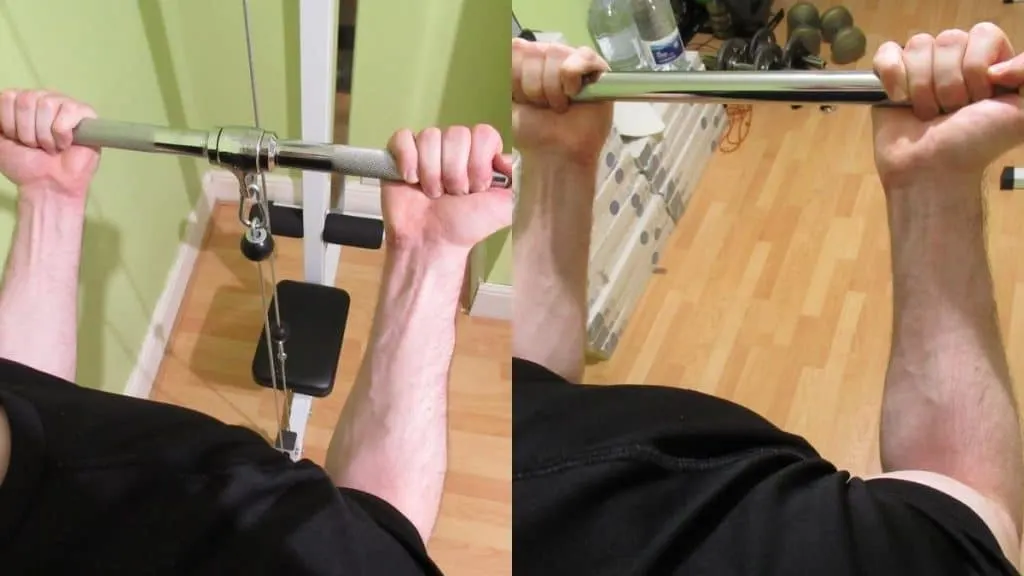Straight bar cable curls are highly effective for building up the bicep muscles because they provide resistance throughout the entire repetition.
On the other hand, barbell curls had already been building the biceps of lifters for decades before cables came on the scene.
So which is the best for muscle growth? Let’s take a look at the differences to find out.
Related: Dumbbell curls or cable curls
The key differences
- You can lift more weight on barbell curls.
- Cable curls are more convenient (no need to load weights onto a bar).
- Cable curls are typically easier on your joints and connective tissue (presuming good lifting technique).
- Barbells are more affordable (worth considering if you train at home).
- You can more easily microload barbells with fractional plates.
- There are more bicep exercises with cables that you can do than with barbells.
Which is the best for hypertrophy?

Hypertrophy—in case you don’t already know—is the scientific word for muscle growth. [1] If you perform either cable curls or barbell curls consistently, then you’ll get rewarded with larger biceps.
As for which is better, you could argue it either way. Cables provide tension at every point during a rep because once you lift the weight plates off the stack, your biceps have to carry the load by themselves. As such, they’re an excellent barbell curl substitute.
But with barbells, you can inadvertently take the tension off your biceps if you pause for too long in the bottom part of the rep.
On the other hand, barbell curls typically enable you to lift heavier weights. This means that you can overload your biceps with higher amounts of resistance and potentially stimulater more muscle growth. Hence, heavy free-weight curls should always be a part of any muscle-building barbell bicep workout.
Which one builds strength faster?

Strength is a function of muscle size because larger muscles can produce more force and thus lift heavier weights. However, there are also numerous neural factors involved in strength. [2] But when talking about gym strength, most people are referring to the practice of getting strong at heavy, often free–weight compound movements.
So since barbells require the most work from your stabilizer muscles, it follows that barbell curls are superior to cable curls for gaining brute strength in the gym. They’re also marginally easier to microload with fractional plates. But if you’re clever, then you can still put microplates on the cable selector pin to make the weight increments more manageable and thus more conducive to strength gain.
You can also check out our dumbbell vs barbell curl comparison if you want to see which free weight option is the most effective for building your biceps.
Which exercise produces a better pump?

Who doesn’t love getting a powerful bicep pump?
There are not many better feelings in the gym than having the skin of your biceps push up against your t-shirt sleeves.
So if you want to maximize your pump, then you should definitely go with cable curls over barbell curls because they provide constant tension by not letting your biceps take a moment’s rest until the set is over.
Remember, however, that it’s the repeated stretching and contracting of a muscle that actually creates the pump. So to get those veins popping, then you need to perform high reps, which you can obviously do with either barbells or cables. Cables simply make the task of getting a pump easier because they provide constant tension.
See our EZ curl bar vs straight bar comparison to learn the differences between these two popular training tools.
Do you need to do both exercises?

In short, no.
You can get by just fine with either exercise. And sometimes it’s actually beneficial—particularly if you find it hard to follow one routine for more than a few weeks—to just pick one exercise and stick with it.
This way, you can actually gain meaningful strength on that exercise, which over time, will result in more impressive bicep development. Program-hopping, on the other hand, will leave you with the same physique for years on end because by changing routines too regularly, you don’t get to progressively overload the staple, mass-building exercises that are responsible for muscle growth.
Yet, if you want to do everything in your power to achieve maximum muscle growth, then your best bet is to include both variations in your routine. That way, you’ll be stimulating more bicep muscle fibers by working your arms from different angles.
Related exercise: Standing alternating cable curls
Cable curls vs barbell curls: The verdict

It’s recommended to include both cable curls and barbell curls in your routine so that you can stimulate faster muscle growth by working your biceps from different angles.
That said, if I could only recommend one exercise, I’d go with barbell curls because they build at least as much muscle mass as cable curls, but they also have better strength carryover to your other free weight exercises. They’re the ideal cable curls substitute if you don’t have access to a gym.
From a purely hypertrophic standpoint, however, cable curls are just as good as barbell curls. Sure, they might not help you much with your free weight exercises, but if you’re just in the pursuit of better bicep development, then the constant tension of cables coupled with the fact that they’re typically more joint-friendly than barbells is hard to beat.
References
- Paul, A. C., & Rosenthal, N. (2002). Different modes of hypertrophy in skeletal muscle fibers. Journal of Cell Biology, 156(4), 751–760. https://doi.org/10.1083/jcb.200105147
- Enoka, R. M. (1988). Muscle Strength and Its Development. Sports Medicine, 6(3), 146–168. https://doi.org/10.2165/00007256-198806030-00003

